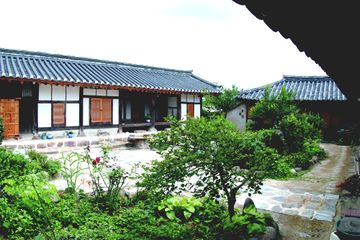단계 박씨고가
| 단계 박씨고가 Historic House of the Bak Family in Dangye-ri |
|
 산청 단계 박씨고가, 국가문화유산포털, 문화재청. |
|
| 대표명칭 | 단계 박씨고가 |
|---|---|
| 영문명칭 | Historic House of the Bak Family in Dangye-ri |
| 한자 | 丹溪 朴氏古家 |
| 주소 | 경상남도 산청군 신등면 단계리 629-4 |
| 지정(등록) 종목 | 경상남도 민속문화재 제4호 |
| 지정(등록)일 | 1983년 8월 12일 |
| 분류 | 유적건조물/주거생활/주거건축/가옥 |
| 시대 | 조선시대 |
| 수량/면적 | 1동 |
| 웹사이트 | 단계 박씨고가, 국가문화유산포털, 문화재청. |
|
|
|
해설문
국문
18세기 경 건립된 것으로 추정되는 이 고가는 용담 박이장의 후손 박상제가 살았던 집이다.
박씨고가는 담장을 사이로 아래, 윗집으로 나누어져 있다. 두 집은 하나의 주택 안에 사랑채와 안채의 관계인 것처럼 보이도록 배치하였으나, 아랫집은 윗집과 분리된 것으로서 일제 시기의 건물이다. 건물은 사랑채와 안채, 문간채를 ‘ℶ’ 모양으로 배치하였는데, 이 지역에서 일반적으로 볼 수 있는 안채와 사랑채를 병렬 형식으로 배치한 것과 차이가 있다.
사랑채는 일반적인 사대부 집안의 사랑채보다 그 규모가 작으며 권위적 상징성을 찾아보기 어렵다. 문간채는 문간 1칸을 포함하여 5칸 규모의 비교적 큰 건물로 창고, 방, 중문, 헛간으로 이루어져 있다. 문간채가 헛간과 방안간 등의 작업 공간과 직접 연결되는 것은 조선 후기 부농 주거의 특색이다. 문간에서 안채가 직접 들여다보이는 것도 내외 관념에 구속되지 않는 부농 계층의 모습을 보여준다.
안채는 정면 6간, 측면 1칸으로 비교적 큰 편이다. 순수한 생활공간으로 2단의 층을 둔 받침 위에 세웠다는 점, 건물 높이나 구조가 다른 건물보다 크다는 점 등은 살림채를 중시하는 부농 주거의 또 다른 특징이다.
전체적으로 조선 후기 부농 가옥의 특징을 잘 간직하고 있는 건물이다.
영문
Historic House of the Bak Family in Dangye-ri
This house was resided in by a descendant of the civil official Bak I-jang (1547-1622) of the Joseon period (1392-1910). It is presumed to have been constructed in the 18th century and has since undergone several repairs. The house shows the typical characteristics of a wealthy farmer’s house from the late Joseon period.
The house consists of a gate quarters, men’s quarters, and women’s quarters. The gate quarters and women’s quarters are aligned in parallel, with the men’s quarters oriented perpendicularly on the right. The women’s quarters consists, from left to right, of a kitchen, main underfloor-heated room, wooden-floored hall, and auxiliary underfloor-heated room. The men’s quarters consists of a wooden-floored hall and two underfloor-heated rooms. The gate quarters consists of a storage room, underfloor-heated room, main gate, and storage room.
When compared to traditional upper-class homes, this wealthy farmer’s house emphasizes practical usability and household management over symbolism and custom. For example, the men’s quarters of an upper-class house is usually large and built with a sense of authority as it was where the master of the house lived and received guests. However, in this house, the women’s quarters is much larger than the men’s quarters and is built on a two-tiered foundation, showing that the women’s sphere – involving management of the household – was of greatest importance. Furthermore, according to Confucian ideology, the men’s and women’s living spaces should be separate and the women’s quarters should be hidden from view from the outside. But, in this house, the women’s quarters shares a courtyard with the men’s quarters and gate quarters, thus allowing ease of access among the buildings.
영문 해설 내용
이 고가는 조선시대의 문신 박이장(1547-1622)의 후손이 살았던 집이다. 18세기경에 건립된 것으로 추정되며, 이후 여러 차례 보수되었다. 전체적으로 조선 후기 부농 가옥의 특징을 잘 보여준다.
집은 안채, 사랑채, 문간채로 이루어져 있다. 문간채와 안채가 마주 보고 있고, 안채와 사랑채를 직각으로 배치하였다. 안채는 왼쪽에서부터 부엌, 안방, 대청, 건넌방으로 이루어져 있고, 사랑채는 대청과 온돌방 2개로 이루어져 있다. 문간채는 창고, 온돌방, 대문, 헛간으로 이루어져 있다.
일반적인 전통 사대부 가옥과 비교해보면, 이 집은 상징성이나 관습보다는 실용성과 살림 공간을 중시하였다. 예를 들어, 사대부 가옥의 사랑채는 남성들이 머물며 손님을 접대하는 공간이기 때문에 규모가 크거나 권위적인 상징성을 갖추도록 지어진다. 그러나 이 집은 안채를 2단의 기단 위에 높고 크게 지어서, 다른 건물들보다 주 살림 공간을 강조하였다. 또한 유교 사상에 따르면, 남녀의 공간을 구분되어야 하고, 안채는 외부에서 쉽게 보이지 않아야 한다. 그러나 이 집은 세 건물이 안마당을 공유하며 서로 열려 있도록 했다.
